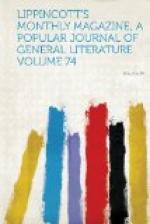The contemporaries and ancient foes of the Northmen, who overthrew the Goths on land and checkmated the Vikings in the southern seas, have a memorial in the beautiful Alhambra-like edifice of the Spanish government. Spain has no architecture so distinctive as that of the Moors, and the selection of their style for the present purpose was in good taste. It lends itself well to this class of building, designed especially for summer use; and many other examples of it will be found upon the grounds. The Mohammedan arch is suited better to materials, like wood and iron, which sustain themselves in part by cohesion, than to stone, which depends upon gravitation alone. Although it stands in stone in a long cordon of colonnades from the Ganges to the Guadalquivir, the eye never quite reconciles itself to the suggestion of untruth and feebleness in the recurved base of the arch. This defect, however, is obtrusive only when the weight supported is great; and the Moorish builders have generally avoided subjecting it to that test.
[Illustration: Plan of exhibition grounds.]
Spain also has taken the liberty of widening the range of her contributions. Soldiers, for instance, find no place in the official classification of subjects for exhibition. She naturally thought it worth while to show that the famous infanteria of Alva, Gonsalvo, and Cuesta “still lived.” So she sends us specimens of the first, if not just now the foremost, of all infantry. This microscopic invasion of our soil by an armed force will be useful in reminding us of the untiring tenacity which takes no note of time or of defeat, and which, indifferent whether the struggle were of six, fifty, or seven hundred years, wore down in succession the Saracens, the Flemings and the French.
[Illustration: JAPANESE BUILDING.]
Samples in this particular walk of competition come likewise from the battle-ground of Europe, Belgium sending a detachment of her troops for police duty. We may add that the Centennial has brought back the red-coats, a detachment of Royal Engineers, backed by part of Inspector Bucket’s men, doing duty in the British division.
After these first drops of the military shower one looks instinctively for the gleam of the spiked helmet at the portals of the German building, seated not far from that of Spain, and side by side with that of Brazil. It does not appear, however. Possibly, Prince Bismarck scorns to send his veterans anywhere by permission. Neither does he indulge us, like Brazil, with the sight of an emperor, or even with caesarism in the dilute form of a crown prince. Such exotics do not transplant well, even for temporary potting, in this republican soil. It is impossible, at the same time, not to reflect what a capital card for the treasury of the exposition would have been the catching of some of them in full bloom, as at the openings of 1867 and 1873. A week of Wilhelm would have caused “the soft German accent,” with its tender “hochs!” to drown all other sounds between Sandy Hook and the Golden Gate.




